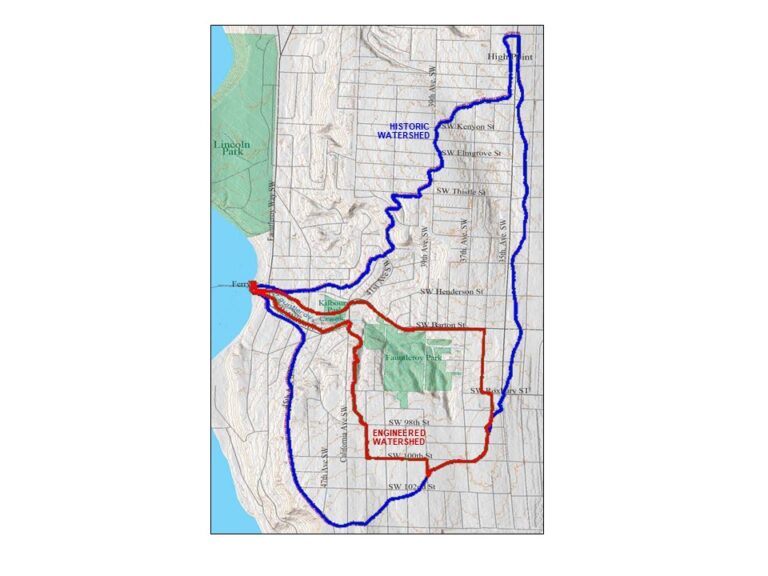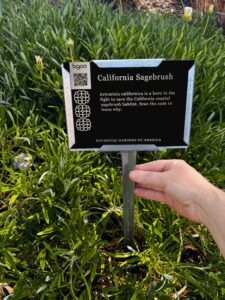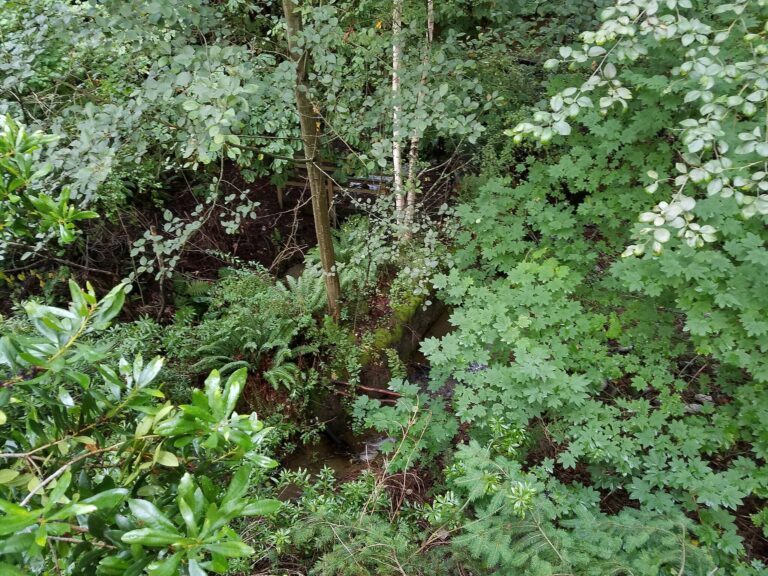In September 2001, the Fauntleroy Watershed Council adopted the first edition of this plan.
Ryan Lewis and Vanessa Pepi launched this update and Judy Pickens and Dennis Hinton organized and edited input from all these participants on the watershed council:
Lindsey Conrad
Pete Draughon
Karen Farnsworth
Dennis Hinton
Ryan Lewis
Rosalie Miller
Kathy Mutchler
Chris Nack
Judy Pickens
Tracy Randle
Phil Sweetland
Tom Trulin
ADOPTED NOVEMBER 2023
OVERVIEW OF THE WATERSHED
The 98-acre Fauntleroy Creek watershed is on Seattle’s Duwamish peninsula, on the western shoreline fronted by central Puget Sound. Except for 28 acres preserved as Fauntleroy Park and the steep-sided ravine that confines the creek channel, the watershed is developed, primarily with single-family housing linked by paved streets.
The mile-long creek is fed by runoff and springs that surface and converge into a main stem at the western boundary of Fauntleroy Park, which is owned and maintained by the City of Seattle as a natural public area. The creek flows in a northwesterly direction through the park, then through alternating culverts and open reaches until emptying into Puget Sound due south of the state ferry terminal in Fauntleroy Cove.
In 1989, a group of neighbors launched Friends of Fauntleroy Creek, a network that grew to encompass citizens, agency specialists, educators, and public officials. Within a year, a grant began funding volunteer water-quality monitoring and public awareness, and the first Summer Youth Employment project had minimally restored a section of the lower creek for salmon habitat. Over the next decade, the scope widened to include creekside education, and salmon began to lure more public and agency interest. After three years of releases by students in the state’s salmon program, the first pair of coho spawners entered the creek in 1994. Because of an impassable culvert a few yards upstream, the fish could not reach restored habitat. In 1998, Seattle Public Utilities replaced the culvert with a passable fishway in time for an estimated 200 coho to come in and spawn, resulting in the creek’s first “home hatch” that winter.
At the same time, an Adopt-a-Park volunteer group took root in Fauntleroy Park. Sparked by neighborhood concern about illegal activities in the park, the effort attracted watershed residents who had long been interested in helping improve stewardship of the park’s many natural assets.
With support from Seattle Parks and Recreation, Friends of Fauntleroy Park established a steering committee and, after additional public input, drafted and prioritized a list of projects. Monthly work parties focused on gaining the upper hand against invasive species such as ivy and clematis that threatened the survival of native vegetation that benefited wildlife and controlled erosion.
Together with special youth projects, the efforts of these volunteers began giving native plants and their seedlings the “breathing room” needed to continue the forest’s natural succession.
GENESIS AND DEVELOPMENT OF THIS PLAN
The projects and programs outlined in this edition of the watershed plan built on more than 30 years of accomplishment by the community and supporting agencies in habitat restoration, water-quality monitoring, public awareness, education, research, and habitat advocacy.
In the two decades since citizens formed the Fauntleroy Watershed Council and adopted the first edition of this plan, much has been accomplished. Much remains to be done, however, including ensuring that gains are maintained. To this end, the council launched a second edition to summarize work completed, highlight ongoing tasks, and respond to new challenges that have arisen, including in nearshore habitat.
ACCOMPLISHMENTS SINCE 1989
A wide-angle view of what citizen stewards with agency partners have accomplished since 1989 reveals an emphasis on making connections
◼ Advocacy for fish passage under Fauntleroy Way SW restored coho salmon’s connection with freshwater and marine habitats and opened opportunities for additional instream restoration.
◼ Public outreach in many forms is enabling students and community residents to connect with the natural rhythms of flora and fauna in the watershed and become responsible stewards.
◼ Greatly improved beneficial habitat in the park is connecting students and the general public with this region’s lowland-forest heritage and ways to value it.
◼ Projects and events have connected citizen stewards with elected officials, agencies, and watershed advocates across the city working toward common goals.
◼ Preservation of data and other information has connected current advocates with the past and will inform the work of future advocates.
ONGOING CHALLENGES
Amplifying and maintaining these gains is not a once-and-done undertaking. Twenty years ago, residents could hardly have imagined today’s breakneck pace of development in the Seattle area, including exploding property values. How can habitat retain its value in the face of pressures to increase density? With shifting city demographics, how might we draw in new stakeholders
from groups not historically engaged in conservation efforts? And how might we mitigate the impact of climate change on formerly resilient species?
If in the face of these challenges natural areas in this urban watershed are to have a positive future, we must
◼ ensure that all investments in the creek system are maintained over the long term so that they
all function and do so in sync.
◼ take into account the common good when weighing ways to open the full extent of the creek system to spawners.
◼ foster beneficial native plant species in public spaces while keeping invasive species at bay and encourage private property owners to do the same.
◼ address sedimentation of the creek.
◼ address dynamics in the creek system associated with climate change.
◼ address non-point pollution and monitor emerging factors so that informative water-quality data is available when weighing possible actions.
◼ continue public outreach to keep area residents informed and invested in the watershed.
◼ continue recruiting volunteers and engaging them in ways that encourage their ongoing participation.
◼ continue supporting Salmon in the Schools and student research for their education and
public-relations value.
Two emphases in the first edition of this plan also continue:
One is that restoration and enhancement are requiring more direction. Eliminating the first barrier to upstream fish migration opened the prospect of eliminating other barriers. If salmon gain access to additional reaches, that additional habitat will need to be restored or enhanced to some degree. Hand in hand with channel and streambank improvements will come the need to give more attention to non-point pollution that diminishes water quality and to erosion (especially from the park) that embeds the channel with silt. As obvious projects in the creek and park are accomplished, more strategizing will be needed to determine what comes next and to attract the resources needed to accomplish it.
The other is that citizen involvement requires more direction. Because we have increased public interest in the park and creek, more watershed residents are wanting to be involved in productive and rewarding ways. Likewise, teachers exposed to these natural resources are seeking opportunities for their students to learn from them. Strategizing and coordinating are needed to take advantage of this interest and enable “pioneer” volunteers to pass the baton.
CORE VALUES
The core values that guided development of a watershed action plan remain much the same:
▪ Emphasize natural habitat.
▪ Respect nature’s innate ability to heal itself.
▪ Cooperate as full partners in an atmosphere of open, timely communication.
▪ Encourage broad citizen input and involvement.
▪ Provide educational opportunities and training for young people.
▪ Respect the rights and concerns of residents adjacent to the park and creek.
▪ Share experience and expertise to benefit other watersheds and inform public policy.
GOALS AND ASPIRATIONS
GOAL 1: Preserve, restore, and enhance native vegetation and aquatic resources for long-term sustainability of natural systems.
a) Increase beneficial habitat by controlling invasive species and revegetating as needed.
b) Use vegetation to direct and restrict pedestrian traffic and stabilize soils.
c) Restore natural in-stream and riparian habitat, reduce non-point pollution, and control erosion and sedimentation, with salmonids as the indicator species.
d) Reconnect the creek system to the extent feasible for migratory fish.
e) Advocate for public policies that promote healthy freshwater and nearshore habitat.
f) Monitor the open-space parcel in the lower creek to ensure that the Green Seattle Partnership completes planned restoration and regularly maintains it.
GOAL 2: Collect and record data that paints a picture of natural systems over time.
a) Monitor salmon life stages, from hatch through spawning. b) Collect data on water quality, vegetation, and other aspects of creek, park, and nearshore habitat as needed to support decision making. c) Make data easily accessible for agency partners, educators, and others. d) Post reports on the website and share with agency partners and other watershed groups.
GOAL 3: Promote habitat-sensitive public enjoyment of Fauntleroy Park.
a) Enhance and maintain a trail system that provides safe, inviting access while minimizing runoff and human impact on sensitive habitat.
b) Block rogue trails that encourage destructive and/or unsafe access.
c) Reinforce habitat-friendly behaviors with signage and other public information.
d) Offer nature walks and other opportunities in the park that promote natural habitat.
e) Incorporate security and maintenance considerations into the design of park structures.
f) Improve accessibility for park visitors who use wheels (strollers, walkers, wheelchairs); work closely with Seattle Parks and benefit from what’s been done elsewhere.
g) Monitor the SW Cambridge St. entrance to the park for damage/safety.
h) Develop and assess an easy-to-navigate wayfinding resource using visitors’ smartphones.
GOAL 4: Encourage environmental education.
a) Support schools in habitat-friendly outdoor education, service learning, and research.
b) Identify opportunities for young people to develop stewardship skills.
c) Use available technology to take full advantage of learning opportunities.
d) Work with area early-learning programs on age-appropriate exploration of habitat in Fauntleroy Park.
e) Continue strong participation in Salmon in the Schools.
f) Create and post a video guide to the creek system, from headwaters to nearshore.
GOAL 5: Facilitate long-term stewardship.
a) Encourage and enable people of all ages to take informed “ownership” of natural areas wherever they live.
b) Cultivate positive relations with residents adjacent to the park and creek corridor.
c) Enhance ties with agencies and groups with expertise, funding, or in-kind services to offer.
d) Monitor the permitting of proposed projects that could negatively impact natural habitat.
e) Incorporate long-term maintenance considerations into the design of all projects.
f) Continually market our stewardship fund to ensure that funding is available to maintain restoration gains.
g) Continue to inform the community through local media about ongoing activities related to these resources.



